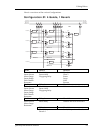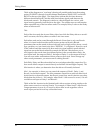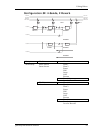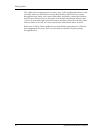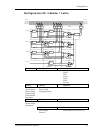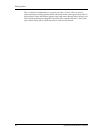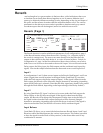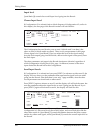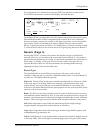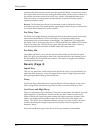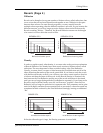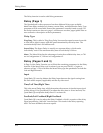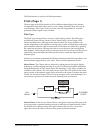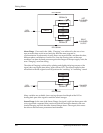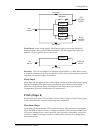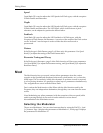
Editing Effects
QuadraSynth Reference Manual 101
If Configuration #2 is selected and you press [EDIT 1] to advance to effect send 2
while the Reverb function is selected, the display will look like this:
PROG EFFECT
PRESET
EDITING: EFFECT
PITCH MOD NAME
CONFIG
REVERB DELAY MIX
PAGE:
1
SEND 2 INPUT: 00
SEND2-IN
PRESET
MIDI
CHAN
MIX
PRESET
12345678910111213141516
2
Quad Knob [1] lets you adjust the level of the signal coming from effect send 2 going
into the Reverb. Send 2 in this Configuration has no effects of its own. Therefore,
there are no input or input mix controls in this page, since there is only one possible
signal choice. Send 2 is intended to be used for signals that you want to send to
Reverb 1, but bypass Delay and Pitch 1. In Configuration #2, send 4 is similar to send
2, in that it has no effects of its own but serves as a bypass going directly to Reverb 3.
Reverb (Page 2)
Pressing the PAGE [®] button will advance the display to Page 2 of the Reverb
function. However, you must have the correct effect send selected (1Ñ4) in order to
get at the Reverb parameters (in Config. #1, the Reverb parameters are found only on
effect send 1; in Config. #2, they are found on sends 1 and 3 since there are two
separate Reverbs). Here you will find parameters for selecting the Reverb type,
adjusting Pre-Delay Time and Pre-Delay Mix.
Reverb Type
The QuadraSynth has seven different reverb types, all stereo, each of which
simulates a different space or produce a different ambient effect. Use Quad Knob [1]
to select one. The different Reverb types are:
Plate 1 & 2. The two Plate reverb types simulate an artificial device known as a Plate.
In the early days of recording, Plates were extremely popular because they were
almost the only way to provide any sort of artificial ambiance to a recording. The
sound of a well-tuned Plate has become quite popular over the years especially when
used on vocal or drum sounds.
Room. The Room reverb type simulates not only rooms of different sizes, but rooms
with different surface materials as well. A room with soft surfaces such as carpet will
produce a reverberant sound with much less high end (treble) than a room with hard
surfaces. This reverb type can easily simulate both examples and many, many more.
Hall. Much larger than a room, Halls are characterized by their high ceilings,
irregular shapes, and generally uniform density of reflections.
Large. Much larger than a hall, this reverb type emulates large ambient spaces such
as amphitheaters, gymnasiums, etc.
Gated. Gated Reverb is a very popular effect on drums first found on English records
in the early 1980s. This reverb type can simulate applying a noise gate (a device that



